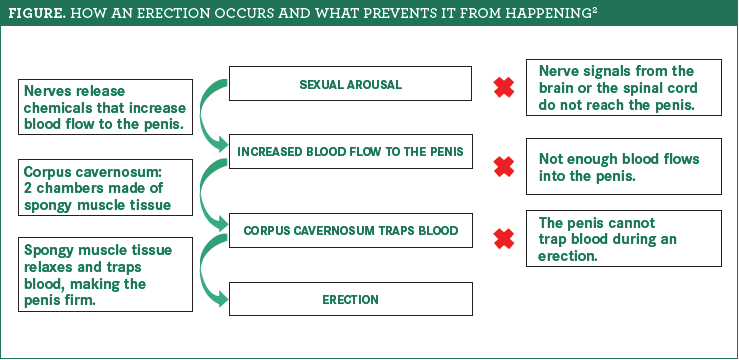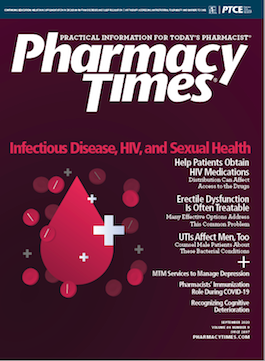Publication
Article
Pharmacy Times
Most Erectile Dysfunction Is Treatable
Medications are remarkably effective at addressing men's most common sexual problem.
Erectile dysfunction (ED), the inability to develop or keep an erection, is men’s most common sexual problem, and it affects about 30 million Americans. ED often occurs when blood flow to the penis is limited or nerves are damaged, often by consistent hyperglycemia in diabetes. ED can signal serious illness, such as atherosclerosis, diabetes, heart disease, and hypertension. Other risk factors include alcohol or tobacco use, an enlarged prostate, psychological factors, sleep disorders, and stress.1,2 Other sexual problems are often mistaken for ED, which is not a decreased interest in sex, occasional trouble having an erection, or structural problems that affect ejaculation.1 Age alone does not cause ED, but the condition is most common in middle-aged and older men.1,2
The figure describes normal erections and what prevents them from occurring.2 Successful erections require a balance of contracting and relaxing agents. About 95% of ED cases are treatable.1

PHOSPHODIESTERASE TYPE 5 INHIBITORS
The most common medications used for ED are phosphodiesterase type 5 (PDE5) inhibitors, which enhance endogenous nitric oxide levels. Of note, an erection occurs only if natural stimulation happens in conjunction with the drug. Four PDE5 inhibitors are FDA approved (see table3-8). They are a mainstay of therapy and are effective and well tolerated in more than 70% of men.3

PDE5 inhibitors’ most common adverse effects (AEs) are back pain, dyspepsia, flushing, headache, flushing, and nasal congestion. Patients need medical attention for erections lasting longer than 4 hours (priapism) or for sudden vision loss in 1 or both eyes. Patients should avoid alcohol when taking PDE5 inhibitors because of the risk of severe hypotension.
Patients can take PDE5 inhibitors with or without food.4-8 Cytochrome P450 3A4 inducers and inhibitors can affect their hepatic metabolism. Combination with nitrates, such as isosorbide dinitrate and nitroglycerin, can create dangerous, sustained vasodilation.3-8 Of note, combining vardenafil with drugs affecting the QTc interval or in patients with a history of arrhythmia is discouraged.7,8
Vardenafil is available as an orally disintegrating tablet (ODT) that patients place on top of the tongue to disintegrate. Patients should not take it with liquid. Vardenafil ODT tablets contain phenylalanine, which can harm patients with phenylketonuria.8 Patients with difficulty swallowing large amounts of liquid, impaired swallowing, or preexisting nausea may prefer the ODT formulation.
ALPROSTADIL
Men who respond poorly to or are intolerant of PDE5 inhibitors may benefit from alprostadil, available as an intracavernosal injection (ICI) or a urethral suppository. Alprostadil, a synthetic prostaglandin E1, activates a cascade that reduces cytoplasmic calcium, binds to smooth muscle cell surface prostaglandin receptors, and causes penile vascular smooth muscle relaxation, or erection.9
Patients self-inject alprostadil ICI into the corpus cavernosum on the side of the penis. Its onset of action is 3 to 5 minutes, with subsequent erections lasting 30 minutes to 12 hours. Alprostadil ICI is effective in 70% to 87% of patients. Its discontinuation rate is 2% to 4%, usually because of penile burning or pain. Patients can use alprostadil ICI 3 times weekly, with at least 24 hours between doses.9
Intraurethral alprostadil improves erectile function in 59% to 78% of men with ED. After the suppository is inserted into the urethra, the drug passes through the urethra and into the corpus cavernosum. Onset is about 5 minutes, resulting in a 30- to 60-minute erection. This formulation’s most frequent AEs are penile or urethral bleeding or pain. Priapism is less common than with ICI alprostadil, but systemic AEs, such as flushing and hypotension, are more common.9
CONCLUSION
Several regenerative or restorative treatments are under investigation for ED.2 These include extracorporeal shock wave therapy, which involves low-intensity shock waves that aim to fix erectile tissues and help restore natural erections; intracavernosal injection of stem cells to help cavernous tissue regrowth; and intracavernosal injection autologous platelet rich plasma, to help cavernous tissue regrowth.
Kelsey Giara, PharmD, is a community pharmacist and a freelance writer in New Hampshire.Jeannette Y. Wick, RPh, MBA, FASCP, is the assistant director of the Office of Pharmacy Professional Development at the University of Connecticut School of Pharmacy in Storrs.
REFERENCES
- Men & diabetes. Centers for Disease Control and Prevention. Updated April 1, 2019. Accessed March 21, 2020. https://www.cdc.gov/diabetes/library/features/diabetes-and-men.html
- What is erectile dysfunction? Urology Care Foundation. Updated June 2018. Accessed March 21, 2020. https://urologyhealth.org/urologic-conditions/erectile-dysfunction(ed)
- Mitidieri E, Cirino G, d’Emmanuele di Villa Bianca R, Sorrentino R. Pharmacology and perspectives in erectile dysfunction in man. Pharmacol Ther. 2020:208:107493. doi:10.1016/j.pharmthera.2020.107493
- Stendra. Prescribing information. VIVUS Inc; 2012. Accessed May 18, 2020. https://www.accessdata.fda.gov/drugsatfda_docs/label/2012/202276s000lbl.pdf
- Viagra. Prescribing information. Pfizer Inc; 1998. Accessed May 18, 2020. https://labeling.pfizer.com/ShowLabeling.aspx?id=652
- Cialis. Prescribing information. Eli Lilly & Co; 2003. Accessed May 18, 2020. http://pi.lilly.com/us/cialis-pi.pdf
- Levitra. Prescribing information. GlaxoSmithKline; 2014. Accessed May 18, 2020. https://www.accessdata.fda.gov/drugsatfda_docs/label/2014/021400s017lbl.pdf
- Staxyn. Prescribing information. Merck & Co Inc; 2010. Accessed May 18, 2020. https://www.accessdata.fda.gov/drugsatfda_docs/label/2010/200179lbl.pdf
- Hanchanale V, Eardley I. Alprostadil for the treatment of impotence. Expert Opin Pharmacother. 2014;15(3):421-428. doi:10.1517/14656566.2014.873789







